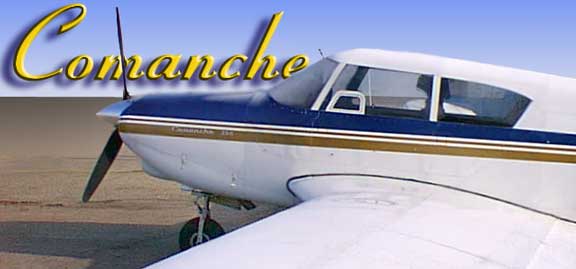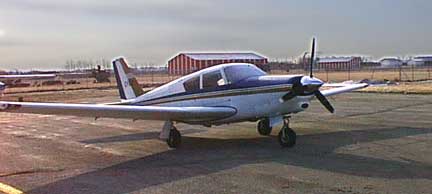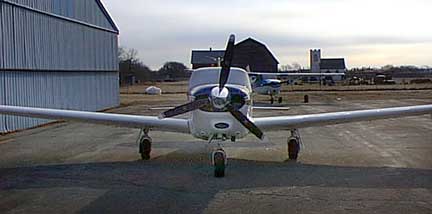 |
| FTLComm - Tisdale - April 11, 2000 |
 The Piper Pa-24 was first introduced in 1958. An inexpensive four place retractable aircraft that was the top of Piper's single engine general aviation aircraft of the time. Initially there were two version of the aircraft this 250hp one and a 180hp machine. In 1964 Piper introduced an eight cylinder 400hp speed demon that present day owners still claim bragging rights to being a "beep-beep" machine. In 1966 the |
 Comanche
came only as a Comanche
came only as a260hp 4-6 place aircraft and is easy to spot because of its extra side window. The relatively low profile and small body contributed to its efficiency and only the Beechcraft Bonanza at more then twice the price was capable of such remarkable performance. This 250hp versions hums along at a cruise speed of 180mph and stalls at 61mph. It has a ceiling of 19,800 and a modest range of 748 miles but can land comfortably in just over a thousand feet. |
 When you compare the Comanche with other singles it has a maximum gross weight of 2,900lbs which is a full two hundred pounds less then the Cessna 182 but the Comanche cruises almost twenty miles per hour faster but the Cessna has a range of more then two hundred miles further. Comparable in many ways to the smaller Mooney pilots of this low cost speedster love their plane. It gained a reputation for low maintenance and its rugged undercarriage is among the sturdiest of retractable singles. |
 This reflective image of the cockpit does not give you a whole lot of information but it is reasonable to say that an aircraft with this sort of performance could get a pilot into a fair amount of trouble as he/she had to "keep in front" of its capabilities. Everyone who flies the Comanche loves its sturdy handling and its large wing span seems to give a better ride then the Hershey bar winged smaller Cherokee series. When this aircraft was in production it was thought that general aviation would continue to evolve just as the auto industry had and that more and more people would learn to fly and that flying itself would become less complex. But as the seventies progressed general aviation |
 was mutilated
with civil was mutilated
with civillaw suits that multiplied the cost of building aircraft and government regulation based on the twenties and thirties prevented adoption of newer technologies into aircraft design. By the eighties Cessna had quit manufacturing and Piper was being bought and sold by one owner after another. In the last decade of the century civil aviation has become the preserve of business and hobbists. The cost and difficulties of flying have made the utilitarian use of private aircraft a thing of the past. There are continued hints that computer technology could open the skies to all but the likelihood of this is remote. The regulations that were established governing construction and power plants in aircraft pretty much will stop cold almost all but the experimental (homebuilt) development of modern flying machines. With home made aircraft the regulations are relaxed enough to permit the use of new composite technologies and lower cost engines. Home builders have built the best airplanes now flying such as Rutan's Vari-eze and Long-eze. But for the ordinary person who wants to experience flying the used aircraft of the sixties are the best and perhaps the only reasonable option. Comanches were not built in large numbers so there are not that many available, but those that are are outstanding buys. One interesting part of the Comanche story is that it was recognised as a great little plane and there were even twin versions of it built which were interesting and unique in the light twin world. But that's another story. |
Click "Here"
to go to Ensign Front page
Ensign, North Central Internet News, published daily by Faster Than Light Communications,
FTLComm